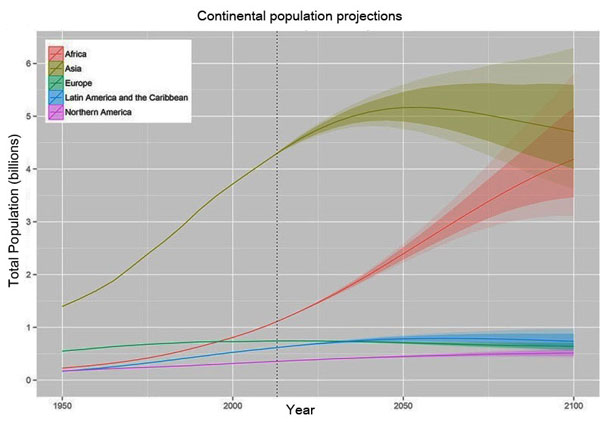Global Demographics and White Survival: What Is to Be Done? Part II
F. Roger Devlin, American Renaissance, October 27, 2017
This essay is part of our symposium on “the world’s most important graph.”

We asked our contributors to answer the following questions: “What should the white West do about this prediction, and what will we do about it?”
Precolonial Africa was far more thinly populated than Europe due both to the inability of its pastoral and primitive agricultural economies to support a dense human population and to the much greater prevalence of disease. The high natural fertility of Africans was an evolutionary response to the precariousness of human life in a disease-ridden environment.
European colonization gradually introduced the fruits of the scientific and industrial revolutions to the continent. These had already produced something of a population explosion in Europe itself, but 1) Europeans have lower natural fertility than Africans, and 2) they lowered it still farther in response to the industrial revolution, a shift in fertility known as “the demographic transition.” The modern world offered a higher standard of living for the white man in part because his newfound resources did not all go to supporting a larger population. This shift was made possible by European self-control and the ability to plan for the future.
Black Africa has never experienced a demographic transition. The effects of Western technology applied to this naturally high-fertility population have been a far more intense and dramatic population explosion that the West ever experienced, and it continues to this day. For example, in 1900, when it was placed under formal British administration, Nigeria had only 16 million people; yet it was by far the most populous African colony. Its population is now 186 million, a more than eleven-fold increase.
Analogous population explosions have been recorded in the animal world among species whose natural predators have been eliminated. They did not turn out well. The most famous example is the spectacular increase in the deer population of Arizona’s Kaibab Plateau, following the “humanitarian” decisions in 1906 to ban hunting and to eliminate all deer predators. By the mid-1920s, the herd had swollen from a few thousand to 100,000, far outstripping the carrying capacity of the land. Soon the hungry animals were eating every last plant on the plateau down to its roots, and massive starvation set in. Food sources were so completely exhausted that it was many years before the plateau could once again support even the modest herds that had lived there before their predators were removed. The final catastrophe was greater than it might otherwise have been because proposals to cull the herd in time were rejected as cruel; the result was a far slower and more agonizing death for a larger number of animals. It was a case of humanitarian sentiment defeating its own purposes.
We do not know what the ultimate carrying capacity of black Africa is or when it will be reached. So far, Western ingenuity has successfully postponed the day of reckoning, but this may only make it more terrible when it arrives. We cannot “cull” Africans as if they were deer, but we can eliminate the misguided humanitarian aid that is doing so much harm (as chronicled here, for example.) Western aid creates a perception among Africans that resources are plentiful, and they respond like the r-strategizers they are: by producing more babies. As on the Kaibab Plateau a century ago, misguided humanitarianism may one day be paid for by the descendants of today’s aid beneficiaries; it could make the Ethiopian famines of the 1980s look like a minor contretemps.
I do not necessarily say that all aid to Africa must be stopped, only that the medical maxim — “first, do no harm” — be strictly applied. Steve Sailer’s proposal to combat environmental limitations on African IQ through micronutrient supplements might make Africans better capable of organizing their societies, and mean that fewer would want to leave for Europe. If supplements were discreetly delivered through food or the water supply, Africans would not see them as an unearned bonanza, and it does no good to encourage Africans to believe that Western handouts will continue for ever. The key point is that in the future, aid should be overseen by men who think like engineers, not by tender-minded Christian clergymen hoping to do good works.
It would be a terrible mistake for white advocates to dismiss the fate of Africa as of no concern to our race; what happens across the Mediterranean from Europe is certain to affect us. We may have almost as much reason as Africans themselves to see the worst prevented.
Obviously, we must be prepared to do what is necessary to defend our own living space, up to and including shooting intruders. Whites are so used to seeing Africans as objects of humanitarian concern that many are unable to grasp that they may also be dangerous rivals. But in fact, fertility is a major advantage they possess over us. We should not attempt to compete with them directly, but we can and must prevent our living space from becoming a dumping ground for their excess fertility. If we fail, it will mean a darker future for all humanity.















